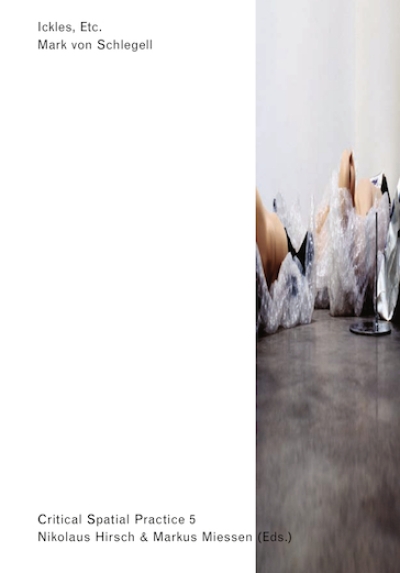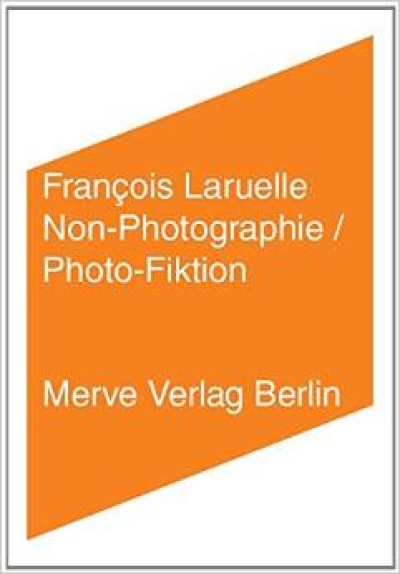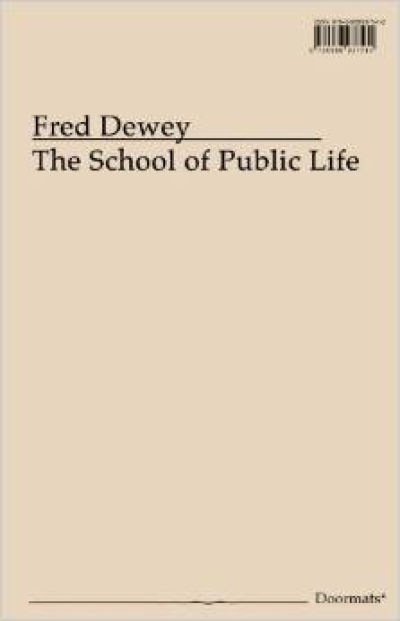gerade nicht auf Lager
Raumlaborberlin (Ed.)
Art City Lab. Neue Räume für die Kunst
gerade nicht auf Lager
Jean-Paul Martinon (Ed.)
The Curatorial. A Philosophy of Curating
gerade nicht auf Lager
SCALE
Einrichten und Zonieren. Raumkonzepte, Ausbau, Materialität
gerade nicht auf Lager
Susanne Hauser, Claus Dreyer (Hg.)
Das Konkrete und die Architektur
Harald Bodenschatz, Piero Sassi, Max…
Urbanism and Dictatorship. A European Perspective
gerade nicht auf Lager
Chris Tedjasukmana
Mechanische Verlebendigung. Ästhetische Erfahrung im Kino
gerade nicht auf Lager
Isabell Lorey
State of Insecurity. Government of the Precarious
gerade nicht auf Lager
Robert Delaunay
Sonia Delaunay. Fashion and Fabrics
gerade nicht auf Lager
Maria Zinfert (Hg.)
Siegfried Kracauer. Fotoarchiv
gerade nicht auf Lager
Christian Thun-Hohenstein (Ed.)
Wege der Moderne. Josef Hoffmann, Adolf Loos und die Folgen…
gerade nicht auf Lager
Olivia de Oliveira
Lina Bo Bardi. Built Work. Obra construida
gerade nicht auf Lager
Eduard Sancho Pou
Function Follows Strategy. Architects' Strategies from…
gerade nicht auf Lager
Orit Halpern
Beautiful Data
Stephanie Kloss
Weltausstellung
gerade nicht auf Lager
Andrea Büttner
Immanuel Kant. Kritik der Urteilskraft
gerade nicht auf Lager
Andri Gerber
Metageschichte der Architektur. Ein Lehrbuch für angehende…
gerade nicht auf Lager
Florian Böhm, Annahita Kamali
Everything is Connected. Home Collection (Vitra)
gerade nicht auf Lager
Eva Diaz
The Experimenters. Chance and Design at Black Mountain…
gerade nicht auf Lager
Honore De Balzac
The Physiology of the Employee
gerade nicht auf Lager
Francesco Spampinato
Come Together. The Rise of Cooperative Art and Design
gerade nicht auf Lager
Marc Bedarida (Ed.)
Le Corbusier. Aventures Photographiques
gerade nicht auf Lager
Ricardo Flores & Eva Prats
Thought by Hand. The Architecture of Flores & Prats
gerade nicht auf Lager
Sylvain Margaine
Forbidden Places, Volume 2: Exploring Our Abandoned Heritage
gerade nicht auf Lager
Mark Leckey
On Pleasure Bent
Axel Wieder, Florian Zeyfang (Eds.)
Open Form. Space, Interaction, and the Tradition of Oskar…
gerade nicht auf Lager
Maria Zinfert (Hg.)
Sigfried Kracauer. Photographic Archive
gerade nicht auf Lager
Clog
World Trade Center
Marta Herford (Ed.)
Der entfesselte Blick. The Unfettered Gaze: Die Brüder…
Hubertus Butin (Hg.)
Begriffslexikon zur zeitgenössischen Kunst (Ausgabe 2014)
gerade nicht auf Lager
Peter Blegvad
Kew. Rhone
gerade nicht auf Lager
Reinhard Seiss
Harry Glück: Wohnbauten
gerade nicht auf Lager
Matthew Gandy
The Fabric of Space. Water, Modernity, and the Urban…
gerade nicht auf Lager
Catherine De Zegher
Women's Work. Is Never Done
gerade nicht auf Lager
Sophie Berrebi
The Shape of Evidence. Contemporary Art and the Document (…
gerade nicht auf Lager
Simon Denny
New Management
gerade nicht auf Lager
Henning Schmidgen
Hirn und Zeit. Die Geschichte eines Experiments 1800 - 1950
Thomas Crow
The Long March Of Pop. Art Music and Design 1930-1995
gerade nicht auf Lager
Chris Kraus
Torpor (Roman)
Gerald Raunig
DIVIDUUM. Maschinischer Kapitalismus und molekulare…
gerade nicht auf Lager
Marc James Léger (Ed.)
The Idea of the Avant Garde And What It Means Today
Jean-Luc Godard
Jean-Luc Godard/JLG: Selbstporträt im Dezember
Dombois, Fliescher, Mersch, Rintz (Hg.)
Ästhetisches Denken. Nicht-Propositionalität, Episteme,…
gerade nicht auf Lager
Emily Pugh
Architecture, Politics, and Identity in Divided Berlin
Markus Grob
Dächerstreit: Flachdach/Steildach
gerade nicht auf Lager
Klingan, Sepahvand, Rosol, Scherer (Eds…
Textures of The Anthropocene. Grain Vapor Ray
gerade nicht auf Lager
Siegfried Kracauer
The Past's Threshold. Essays on Photography
gerade nicht auf Lager
Philip Jodidio
Cabins. Hütten. Cabanes
gerade nicht auf Lager
Space Caviar (Eds.)
SQM. The Quantified Home: An exploration of the evolving…
testcard #24
Bug Report. Digital war besser
gerade nicht auf Lager
T'ai Smith
Bauhaus Weaving Theory. From Feminine Craft to Mode of…
gerade nicht auf Lager
Klaus Dömer, Hans Drexler, Joachim…
Affordable Living. Housing for Everyone
gerade nicht auf Lager
Slavoj Zizek
Trouble in Paradise. From the End of History to the End of…
gerade nicht auf Lager
Renée Green
Other Planes of There
gerade nicht auf Lager
Stephen Grabow, Kent Spreckelmeyer
The Architecture of Use. Aesthetics and Function in…
gerade nicht auf Lager
Manfred Hermes
Hystericizing Germany
gerade nicht auf Lager
Metahaven
Can Jokes Bring Down Governments? Memes, Design and…
gerade nicht auf Lager
Spyros Papapetros, Julian Rose (Eds.)
Retracing the Expanded Field
gerade nicht auf Lager
Felix Denk, Sven von Thülen
Der Klang der Familie: Berlin, Techno and the Fall of the…
gerade nicht auf Lager
Francesco Garutti (Ed.)
Fairland. Explorations, Insights and Outlooks on the Future…
gerade nicht auf Lager
Dante Bini
Building with Air
Birgit Mennel, Stefan Nowotny (Hg.)
Die Sprachen der Banlieues
gerade nicht auf Lager
Precarias a la Deriva
Was ist dein Streik? Militante Streifzüge durch die…
gerade nicht auf Lager
Joseph Becker, Jennifer Dunlop Fletcher…
Lebbeus Woods, Architect
gerade nicht auf Lager
Binna Choi, Maiko Tanaka (Hg)
The Grand Domestic Revolution Handbook
gerade nicht auf Lager
Boris Kralj
My Belgrade (2nd Edition)
gerade nicht auf Lager
Frances Stracey
Constructed Situations. A New History of the Situationist…
Latek, Paviol, Simond, Very (Eds.)
In situ – de visu – in motu. Architecture, cinéma et arts…
gerade nicht auf Lager
Neil Spiller, Nic Clear (Eds.)
Educating Architects. How Tomorrow's Practitioners…
gerade nicht auf Lager
Tsitsi Ella Jaji
Africa in Stereo. Modernism, Music, And Pan-African…
gerade nicht auf Lager
AndresLepik, Very Simone Bader (Hg)
Lina Bo Bardi 100. Brasiliens alternativer Weg in die…
gerade nicht auf Lager
Jenn Joy
The Choreographic
gerade nicht auf Lager
Robert Hamelijnck, Nienke Terpsma (Eds.)
It's Playtime
Nicolas Bruno Jacquet
Le Langage Hypermoderne de l'Architecture
Gertrud Lehnert, Alicia Kühl, Katja…
Modetheorie. Klassische Texte aus vier Jahrhunderten
Katharina Eck, Astrid Silvia Schänhagen
Interieur und Bildtapete. Narrative des Wohnens um 1800
gerade nicht auf Lager
Boelen / Z33, Sacchetti (Eds.)
Designing Everyday Life
Stefan Gandl
Neubau Forst Catalogue
gerade nicht auf Lager
Anthony Downey
Art and Politics Now
Jörg H. Gleiter (Hg.)
Symptom Design. Vom Zeigen und Sich-Zeigen der Dinge
gerade nicht auf Lager
Negative (Ed.)
Auto - Self-representation and Digital Photography
gerade nicht auf Lager
Chloé Griffin (Ed.)
Edgewise. A Picture of Cookie Mueller
gerade nicht auf Lager
Discoteca Flaming Star, J. P. Raether (…
Zeig her, Führ vor, Tausch ein: Performance - Art -…
Daniel Wrana, Alexander Ziem, et al. (…
DiskursNetz. Wörterbuch der interdisziplinären…
gerade nicht auf Lager
Teresa Calonje (Ed.)
Live Forever. Collecting Live Art
gerade nicht auf Lager
Raphaëlle Saint-Pierre
Villas 60-70 en France
gerade nicht auf Lager
Claire Zimmerman
Photographic Architecture in the Twentieth Century
gerade nicht auf Lager
Olesya Turkina
Soviet Space Dogs
gerade nicht auf Lager
Susanne Witzgall, Kerstin Stakemeier (…
Macht des Materials / Politik der Materialität
gerade nicht auf Lager
Jörg H. Gleiter
Ornament Today. Digital Material Structural
gerade nicht auf Lager
Mladen Dolar
His Master's Voice. Eine Theorie der Stimme
gerade nicht auf Lager
Jonathan Crary
24/7: Schlaflos im Spätkapitalismus
gerade nicht auf Lager
Fulcrum (Ed.)
Real Estates. Life without Debt
gerade nicht auf Lager
Sylvie Estrada
Setting the Scene - Exploring Set Design
gerade nicht auf Lager
Andrew Feenberg
The Philosophy Of Praxis: Marx, Lukács And The Frankfurt…
Mark von Schlegell
Ickles, Etc. Critical Spatial Practice 5
gerade nicht auf Lager
François Laruelle
Non-Photographie / Photo-Fiktion
Simon Starling
Metamorphology
gerade nicht auf Lager
Fred Dewey
The School of Public Life


































































































